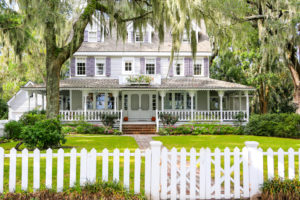
If you live in an old or historic home, you know it requires a different type of care than newer homes. The same features that make it special – things like wood clapboard and floors, plaster walls and beautiful architectural details – are what make caring for it a labor of love. If you’re painting over old exterior paint, you’ll need to know a few tips and tricks before you get started.
Paint is More Than Paint
The first thing you should know is that paint is more than just color. It’s the protective coating that protects your home from damaging agents like harsh sunshine, rain, snow and humidity. When painting over old exterior paint, buy the best-quality paint you can afford. Then, follow these tips.
How to Paint Over Old Exterior Paint
Painting over old exterior paint could require a little elbow grease, depending on how long it’s been between paint jobs. Here are the steps for painting an old wood house:
Scrape* – The first step in painting over old exterior paint is scraping* off the old, chipped paint. You can do this with scrapers, grinders or chemicals, which will dissolve the old paint.
Clean – Use a power washer or a long-handled brush to clean the walls.
Fill – Got gaps? Fill any cracks, holes or gaps with fillers – flexible filler is best, since it lets the walls expand and contract with the temperatures.
Sand* – If you used filler, sand the spots you filled to create a smooth surface.
Prime – Apply one coat of primer — more if you’re going from a dark color to a light one.
Paint – Apply at least two coats of paint.
Colors for Older or Historic Homes
Because older homes often have more wood trim and architectural details than newer ones, so they’re often painted in brighter hues that highlight those details.
Also, older homes are typically painted with historically accurate color schemes. You can find historic color schemes through the usual channels — design books, Pinterest and design sites — or by asking a paint pro to help you pick an appropriate scheme. You can also paint over old exterior paint with the home’s original paint color.
Other popular colors for older or historic homes include:
- White
- Light yellow
- Sage green
In addition to historic wall colors, many older or historic homes were painted with contrasting trim — and not always white trim. This along with shutters, often painted black or Charleston green, enhance the unique style of historic or older homes.
If you still need some help picking the color scheme for your older or historic home, reach out to our color consultants. They’ll not only help you pick a color for your home, they’ll also send you free paint color samples. And if you’re interested in learning more about our exterior residential paint services, get a free quote.
*WARNING! If you scrape, sand, or remove old paint, you may release lead dust. LEAD IS TOXIC. EXPOSURE TO LEAD DUST CAN CAUSE SERIOUS ILLNESS, SUCH AS BRAIN DAMAGE, ESPECIALLY IN CHILDREN. PREGNANT WOMEN SHOULD ALSO AVOID EXPOSURE. Wear a NIOSH-approved respirator to control lead exposure. Clean up carefully with a HEPA vacuum and a wet mop. Before you start, find out how to protect yourself and your family by contacting the National Lead Information Hotline at 1-800-424-LEAD or log on to www.epa.gov/lead.